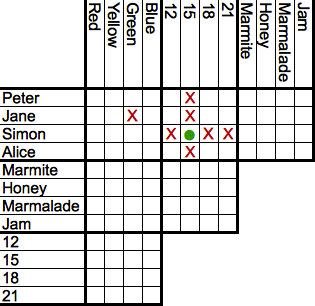Logic Puzzle on:
[Wikipedia]
[Google]
[Amazon]
A logic puzzle is a 
puzzle
A puzzle is a game, problem, or toy that tests a person's ingenuity or knowledge. In a puzzle, the solver is expected to put pieces together ( or take them apart) in a logical way, in order to find the solution of the puzzle. There are differe ...
deriving from the mathematical
Mathematics is a field of study that discovers and organizes methods, Mathematical theory, theories and theorems that are developed and Mathematical proof, proved for the needs of empirical sciences and mathematics itself. There are many ar ...
field of deduction.

History
The logic puzzle was first produced byCharles Lutwidge Dodgson
Charles Lutwidge Dodgson (27 January 1832 – 14 January 1898), better known by his pen name Lewis Carroll, was an English author, poet, mathematician, photographer and reluctant Anglican deacon. His most notable works are ''Alice's Adventures ...
, who is better known under his pen name Lewis Carroll, the author of ''Alice's Adventures in Wonderland
''Alice's Adventures in Wonderland'' (also known as ''Alice in Wonderland'') is an 1865 English Children's literature, children's novel by Lewis Carroll, a mathematics university don, don at the University of Oxford. It details the story of a ...
''. In his book '' The Game of Logic'' he introduced a game to solve problems such as confirming the conclusion "Some greyhounds are not fat" from the statements "No fat creatures run well" and "Some greyhounds run well". Puzzles like this, where we are given a list of premises and asked what can be deduced from them, are known as syllogism
A syllogism (, ''syllogismos'', 'conclusion, inference') is a kind of logical argument that applies deductive reasoning to arrive at a conclusion based on two propositions that are asserted or assumed to be true.
In its earliest form (defin ...
s. Dodgson goes on to construct much more complex puzzles consisting of up to 8 premises.
In the second half of the 20th century mathematician Raymond M. Smullyan continued and expanded the branch of logic puzzles with books such as '' The Lady or the Tiger?'', '' To Mock a Mockingbird'' and ''Alice in Puzzle-Land''. He popularized the " knights and knaves" puzzles, which involve knights, who always tell the truth, and knaves, who always lie.
There are also logic puzzles that are completely non-verbal in nature. Some popular forms include Sudoku
Sudoku (; ; originally called Number Place) is a logic puzzle, logic-based, combinatorics, combinatorial number-placement puzzle. In classic Sudoku, the objective is to fill a 9 × 9 grid with digits so that each column, each row, and ...
, which involves using deduction to correctly place numbers in a grid; the nonogram
Nonograms, also known as Hanjie, Paint by Numbers, Griddlers, Pic-a-Pix, and Picross, are picture logic puzzles in which cells in a grid must be colored or left blank according to numbers at the edges of the grid to reveal a hidden picture. In ...
, also called "Paint by Numbers", which involves using deduction to correctly fill in a grid with black-and-white squares to produce a picture; and logic mazes, which involve using deduction to figure out the rules of a maze.
Logic grid puzzles
Another form of logic puzzle, popular among puzzle enthusiasts and available inmagazine
A magazine is a periodical literature, periodical publication, print or digital, produced on a regular schedule, that contains any of a variety of subject-oriented textual and visual content (media), content forms. Magazines are generally fin ...
s dedicated to the subject, is a format in which the set-up to a scenario is given, as well as the object (for example, determine who brought what dog to a dog show, and what breed each dog was), certain clues are given ("neither Misty nor Rex is the German Shepherd"), and then the reader fills out a matrix with the clues and attempts to deduce the solution. These are often referred to as "logic grid" puzzles. The data set of a logic grid puzzles can be any number of categories, but are limited by the corresponding increase in complexity, with most having only two, three, or even four categories.
While designed more as a table-based puzzle than a matrix, the most famous example of a logic-grid puzzle may be the so-called Zebra Puzzle, which asks the question ''Who Owned the Zebra?''.
Common in logic puzzle magazines are derivatives of the logic grid puzzle called "table puzzles" that are deduced in the same manner as grid puzzles, but lack the grid either because a grid would be too large, or because some other visual aid is provided.
For example, a map of a town might be present in lieu of a grid in a puzzle about the location of different shops.
See also
* :Logic puzzles, a list of different logic puzzles *List of puzzle video games
This is a partial list of notable puzzle video games, sorted by general category.
Tile matching
Tile-matching video games are a type of puzzle video game where the player manipulates tiles in order to make them disappear according to a matchi ...
* Logic programming
Logic programming is a programming, database and knowledge representation paradigm based on formal logic. A logic program is a set of sentences in logical form, representing knowledge about some problem domain. Computation is performed by applyin ...
* Mechanical puzzle
A mechanical puzzle is a puzzle presented as a set of mechanically interlinked pieces in which the solution is to manipulate the whole object or parts of it. While puzzles of this type have been in use by humanity as early as the 3rd century BC ...
* Recreational mathematics
Recreational mathematics is mathematics carried out for recreation (entertainment) rather than as a strictly research-and-application-based professional activity or as a part of a student's formal education. Although it is not necessarily limited ...
* Muddy Children Puzzle
* Survo puzzle
* Murdle
References
Sources
* {{Authority control * Informal logic